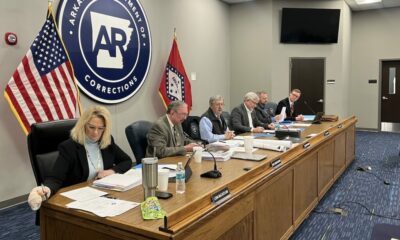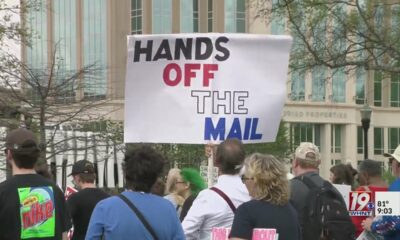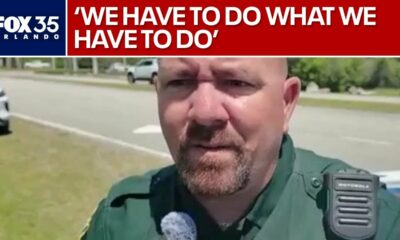Kaiser Health News
California Hospitals Seek a Broad Bailout, but They Don’t All Need It
by Samantha Young and Angela Hart
Thu, 25 May 2023 09:00:00 +0000
SACRAMENTO, Calif. — One of the country’s richest hospitals, which caters to Hollywood elites, accepted nearly $28 million last year from an unusual source: a charity that siphons money from other California hospitals, many of which serve the state’s poorest residents.
Cedars-Sinai Health System in Los Angeles secured the grant under California’s recession-era financing scheme that allows wealthy hospitals to take valuable health care tax money from poorer ones. Hospitals across the state agreed in 2009 to the arrangement in order to tap billions more per year in taxpayer dollars to support the state’s Medicaid program, called Medi-Cal.
Now, some of those hospitals serving a greater share of Medi-Cal patients are in dire financial need and face cutbacks and potential closures. But instead of asking for help for only those at greatest risk, California’s powerful hospital industry is putting the squeeze on Gov. Gavin Newsom and fellow Democratic lawmakers for an unprecedented bailout. And they are doing it even as the state faces a nearly $32 billion budget deficit.
Hospitals argue that to avert a crisis, they need an emergency infusion of $1.5 billion. They also want a steady annual stream of new health care tax money despite already having their own dedicated tax intended to support struggling facilities that serve a large percentage of the state’s low-income people, such as Madera Community Hospital in the Central Valley, which closed earlier this year.
Ads by the California Hospital Association paint a scary picture: “1 in 5 Hospitals are at risk of closure.” Yet another warns, “Health care that millions rely on is at risk.” Those claims are being repeated by state lawmakers as they debate financial rescue for hospitals.
But a KFF Health News analysis of state data revealed that despite increased labor costs and inflation, many California hospitals have been profitable in recent years. The industry earned roughly $131 billion last year in patient revenue, a key indicator of profitability — $7.3 billion more than the previous year. After factoring in rising costs, the industry still turned a profit of about $207 million last year. State figures show the industry reaped $9.2 billion in patient revenue in 2021, partly a reflection of big swings in the stock market.
Leading health care finance experts and former state officials are urging Newsom and lawmakers to resist the industry’s fear tactics, saying that, even though hospitals are still reeling from the covid-19 pandemic, many have plush financial reserves.
“They are big fans of these giant bailouts, where the relatively rich hospitals benefit as well as the ones who really need it,” said Glenn Melnick, a health economist at the University of Southern California. “A big chunk of the hospitals, even if they’re losing money, don’t need taxpayer money to help them through this crisis.”
Melnick and others who have analyzed the financial state of California hospitals say a sliver of California’s 368 general hospitals are in crisis and that relief should be given only to those that can show they are in immediate peril. Many hospitals in underserved and rural communities are struggling financially, in part because they have failed to attract enough patients with private insurance. And the cost of providing care to lower-income patients who rely on Medi-Cal hasn’t kept pace with government reimbursement rates.
But low Medi-Cal rates aren’t necessarily a predictor of financial disaster, according to a report released Thursday by the California Health Care Foundation. (KFF Health News publishes California Healthline, which is an editorially independent service of the California Health Care Foundation.)
Health economists found that hospitals “with the lowest margins were no more dependent on Medi-Cal or Medicare than the average California hospital.” And many cash-strapped hospitals may be sitting on enormous wealth, an indication they don’t necessarily need more taxpayer money.
“Most of the facilities that have negative margins are a part of larger systems, which suggests that they have the underlying wealth of those systems to stabilize them,” said Kristof Stremikis, director of market analysis and insight for the foundation.
Carmela Coyle, the influential leader of the state hospital lobby, said California’s hospitals are in the worst crisis they’ve faced in recent history, largely because the state reimburses providers just 74 cents on the dollar to care for Medi-Cal patients.
“You have these underserved communities in the Central Valley, where a hospital comes in, they’re doing their best, and those underserved individuals are not reimbursed the same as everybody else,” Coyle told KFF Health News. “The real underlying issue here is government underfunding.”
But Coyle isn’t disclosing the full picture. Experts agree that reimbursement rates in Medi-Cal — money provided to doctors, clinics, and hospitals for taking care of low-income patients — are too low to cover the actual cost of care. Yet the state and federal government give billions in bonus and incentive payments that can actually result in higher reimbursements and even profits.
After Madera Community Hospital cut off services and shuttered, Coyle warned that it was a “canary in the coal mine” for other hospitals unable to make ends meet because of its high proportion of low-income patients and reliance on government payments. But the hospital actually made nearly $15 million from Medi-Cal in 2021, KFF Health News has gleaned from state hospital financial records.
The overarching problem, according to emails obtained by KFF Health News, was an inability to demand higher payments from commercial health insurance companies, as well as attract their patients — 70% of whom sought care outside Madera County.
The hospital “does not have the ability to negotiate competitive rates on its own,” according to an email last June to the California attorney general’s office from representatives of Trinity Health, a national Catholic health system, which backed off from acquiring the hospital.
The Madera hospital’s CEO, Karen Paolinelli, and other hospital leaders made another last-ditch effort to keep its doors open: They asked for an advance payment of their hospital tax revenue — money distributed through health insurance plans and the state. The payment they sought was from the Hospital Quality Assurance Fee, which allows hospitals to tax themselves to draw in federal money for Medi-Cal. Adopted in California in 2009 and later approved by voters through a ballot initiative, the tax brought in $8.4 billion last year.
“We did ask before we closed to get paid some of the provider money owed to us,” Paolinelli said. “But we were not successful.”
She said the hospital needed $5 million to remain open and couldn’t secure funding in time.
Under the hospital tax revenue, the money is spread across California hospitals, but the system is designed to protect the rich hospitals and essentially help them avoid industry taxes.
Hospitals with a greater share of low-income patients pay a higher tax than wealthier systems that don’t serve as many poor people. However, they benefit handsomely, ultimately increasing how much they are paid to care for Medi-Cal patients. Then those hospitals give up a portion of their tax money to a charity that funnels it to better-performing hospitals in exchange for their political support for the hospital tax.
“The winner hospitals contribute money to a fund that is used to distribute money to the loser hospitals,” said Elaine Batchlor, CEO of MLK Community Health, which is asking for financial help because roughly 70% of its patients are on Medi-Cal. “No hospital loses by being a part of it. If you were going to lose money, you’d be against it.”
The transactions are routed through the California Health Foundation and Trust, the charity operated by the leadership of the California Hospital Association.
For example, Cedars-Sinai paid nearly $172 million in taxes in 2022, eclipsing the $151 million it got back in additional Medi-Cal dollars. To make up for the loss, it secured the nearly $28 million in grant revenue — earning nearly $6.9 million from the program, its commissioned tax audit shows.
Cedars-Sinai spokesperson Duke Helfand acknowledged the benefit from the taxing scheme but said the health system effectively subsidizes Medi-Cal enrollees and incurs losses of more than $180 million annually serving those low-income patients. “Over the years, our teams at Cedars-Sinai have effectively managed our financial resources, enabling us to provide exceptional patient care,” Helfand said.
By comparison, the faith-based Adventist Health, which serves more poor people and operates roughly two dozen hospitals in California, Oregon, and Hawaii, paid $148 million in taxes in 2022 and reaped $401 million in additional Medi-Cal dollars through the program, according to its independent tax audit. It then contributed $3 million of that money to the charity.
These sorts of financing arrangements are under federal scrutiny. Officials with the Centers for Medicare & Medicaid Services have blasted “hold harmless” deals that can result in wealthier hospitals receiving enough money back that they ultimately wind up paying little or no tax at all.
“A health care-related tax cannot have a hold harmless provision that guarantees to return all or a portion of the tax back to the taxpayer,” Daniel Tsai, deputy administrator and director for the federal Medicaid agency, wrote in February.
Dave Regan, president of Service Employees International Union-United Healthcare Workers West, which represents hospital workers, has long lambasted California’s scheme as a ploy that lets wealthy hospitals siphon valuable health care dollars from smaller, rural hospitals that need more support for Medi-Cal patients.
“We believe the policies and practices of the hospital industry, in large part, contribute to the problems that Madera faced,” Regan said. “The hospital industry is richer than it’s ever been — and it’s being disingenuous, trying to get the public to fork over more money at a time when they have more money than they’ve ever had.”
California Hospital Association spokesperson David Simon defended the charity, saying it helps “hospitals provide health care services despite losses” from the tax.
Hospital leaders say exorbitant costs and inflation have created extreme financial woes. Last year, California’s hospitals paid at least $10 billion more for labor, supplies, and other expenses than the year before, according to state hospital finance data. And overall, they saw substantially smaller investment gains, reporting nearly $119 million in non-operating revenue compared with $6 billion the year before — a big blow to their financial cushion to ensure patient care.
The industry points out 200 hospitals had negative operating margins last year, yet KFF Health News found that, even before the pandemic, about 160 hospitals reported losing money in their operating budgets. Experts say the finding underscores the reality that hospitals operate on slim margins.
And, credit ratings agencies have recently upgraded the bonds of a number of hospitals and health systems, including Sutter Health in Northern California and Loma Linda University Medical Center in San Bernardino County.
“We just upgraded Sutter like two weeks ago, so it would be very hard-pressed, for me, to look at California and say California is looking bad,” said Kevin Holloran, a senior director at Fitch Ratings.
Some Democratic lawmakers agree that not all hospitals need a bailout. Instead, they favor targeted relief such as a $150 million loan program that Newsom signed into law earlier this month to help struggling hospitals.
“I’m not a big fan of writing everybody a check,” said Democratic Assemblymember Jim Wood, chair of the Health Committee, who says hospitals ought to be more transparent about their finances before state taxpayers give them any more money. “If you’re a hospital system that’s doing well, I don’t believe you should be getting any additional resources from the state.”
KFF Health News senior correspondent Bernard J. Wolfson contributed to this report.
This article was produced by KFF Health News, which publishes California Healthline, an editorially independent service of the California Health Care Foundation.
KFF Health News is a national newsroom that produces in-depth journalism about health issues and is one of the core operating programs at KFF—an independent source of health policy research, polling, and journalism. Learn more about KFF.
USE OUR CONTENT
This story can be republished for free (details).
By: Samantha Young and Angela Hart
Title: California Hospitals Seek a Broad Bailout, but They Don’t All Need It
Sourced From: kffhealthnews.org/news/article/california-hospital-funding-bailouts-hospital-quality-assurance-fee-program/
Published Date: Thu, 25 May 2023 09:00:00 +0000
Kaiser Health News
US Judge Names Receiver To Take Over California Prisons’ Mental Health Program
SACRAMENTO, Calif. — A judge has initiated a federal court takeover of California’s troubled prison mental health system by naming the former head of the Federal Bureau of Prisons to serve as receiver, giving her four months to craft a plan to provide adequate care for tens of thousands of prisoners with serious mental illness.
Senior U.S. District Judge Kimberly Mueller issued her order March 19, identifying Colette Peters as the nominated receiver. Peters, who was Oregon’s first female corrections director and known as a reformer, ran the scandal-plagued federal prison system for 30 months until President Donald Trump took office in January. During her tenure, she closed a women’s prison in Dublin, east of Oakland, that had become known as the “rape club.”
Michael Bien, who represents prisoners with mental illness in the long-running prison lawsuit, said Peters is a good choice. Bien said Peters’ time in Oregon and Washington, D.C., showed that she “kind of buys into the fact that there are things we can do better in the American system.”
“We took strong objection to many things that happened under her tenure at the BOP, but I do think that this is a different job and she’s capable of doing it,” said Bien, whose firm also represents women who were housed at the shuttered federal women’s prison.
California corrections officials called Peters “highly qualified” in a statement, while Gov. Gavin Newsom’s office did not immediately comment. Mueller gave the parties until March 28 to show cause why Peters should not be appointed.
Peters is not talking to the media at this time, Bien said. The judge said Peters is to be paid $400,000 a year, prorated for the four-month period.
About 34,000 people incarcerated in California prisons have been diagnosed with serious mental illnesses, representing more than a third of California’s prison population, who face harm because of the state’s noncompliance, Mueller said.
Appointing a receiver is a rare step taken when federal judges feel they have exhausted other options. A receiver took control of Alabama’s correctional system in 1976, and they have otherwise been used to govern prisons and jails only about a dozen times, mostly to combat poor conditions caused by overcrowding. Attorneys representing inmates in Arizona have asked a judge to take over prison health care there.
Mueller’s appointment of a receiver comes nearly 20 years after a different federal judge seized control of California’s prison medical system and installed a receiver, currently J. Clark Kelso, with broad powers to hire, fire, and spend the state’s money.
California officials initially said in August that they would not oppose a receivership for the mental health program provided that the receiver was also Kelso, saying then that federal control “has successfully transformed medical care” in California prisons. But Kelso withdrew from consideration in September, as did two subsequent candidates. Kelso said he could not act “zealously and with fidelity as receiver in both cases.”
Both cases have been running for so long that they are now overseen by a second generation of judges. The original federal judges, in a legal battle that reached the U.S. Supreme Court, more than a decade ago forced California to significantly reduce prison crowding in a bid to improve medical and mental health care for incarcerated people.
State officials in court filings defended their improvements over the decades. Prisoners’ attorneys countered that treatment remains poor, as evidenced in part by the system’s record-high suicide rate, topping 31 suicides per 100,000 prisoners, nearly double that in federal prisons.
“More than a quarter of the 30 class-members who died by suicide in 2023 received inadequate care because of understaffing,” prisoners’ attorneys wrote in January, citing the prison system’s own analysis. One prisoner did not receive mental health appointments for seven months “before he hanged himself with a bedsheet.”
They argued that the November passage of a ballot measure increasing criminal penalties for some drug and theft crimes is likely to increase the prison population and worsen staffing shortages.
California officials argued in January that Mueller isn’t legally justified in appointing a receiver because “progress has been slow at times but it has not stalled.”
Mueller has countered that she had no choice but to appoint an outside professional to run the prisons’ mental health program, given officials’ intransigence even after she held top officials in contempt of court and levied fines topping $110 million in June. Those extreme actions, she said, only triggered more delays.
The 9th U.S. Circuit Court of Appeals on March 19 upheld Mueller’s contempt ruling but said she didn’t sufficiently justify calculating the fines by doubling the state’s monthly salary savings from understaffing prisons. It upheld the fines to the extent that they reflect the state’s actual salary savings but sent the case back to Mueller to justify any higher penalty.
Mueller had been set to begin additional civil contempt proceedings against state officials for their failure to meet two other court requirements: adequately staffing the prison system’s psychiatric inpatient program and improving suicide prevention measures. Those could bring additional fines topping tens of millions of dollars.
But she said her initial contempt order has not had the intended effect of compelling compliance. Mueller wrote as far back as July that additional contempt rulings would also be likely to be ineffective as state officials continued to appeal and seek delays, leading “to even more unending litigation, litigation, litigation.”
She went on to foreshadow her latest order naming a receiver in a preliminary order: “There is one step the court has taken great pains to avoid. But at this point,” Mueller wrote, “the court concludes the only way to achieve full compliance in this action is for the court to appoint its own receiver.”
This article was produced by KFF Health News, which publishes California Healthline, an editorially independent service of the California Health Care Foundation.
If you or someone you know may be experiencing a mental health crisis, contact the 988 Suicide & Crisis Lifeline by dialing or texting “988.”
The post US Judge Names Receiver To Take Over California Prisons’ Mental Health Program appeared first on kffhealthnews.org
Kaiser Health News
Amid Plummeting Diversity at Medical Schools, a Warning of DEI Crackdown’s ‘Chilling Effect’
The Trump administration’s crackdown on DEI programs could exacerbate an unexpectedly steep drop in diversity among medical school students, even in states like California, where public universities have been navigating bans on affirmative action for decades. Education and health experts warn that, ultimately, this could harm patient care.
Since taking office, President Donald Trump has issued a handful of executive orders aimed at terminating all diversity, equity, and inclusion, or DEI, initiatives in federally funded programs. And in his March 4 address to Congress, he described the Supreme Court’s 2023 decision banning the consideration of race in college and university admissions as “brave and very powerful.”
Last month, the Education Department’s Office for Civil Rights — which lost about 50% of its staff in mid-March — directed schools, including postsecondary institutions, to end race-based programs or risk losing federal funding. The “Dear Colleague” letter cited the Supreme Court’s decision.
Paulette Granberry Russell, president and CEO of the National Association of Diversity Officers in Higher Education, said that “every utterance of ‘diversity’ is now being viewed as a violation or considered unlawful or illegal.” Her organization filed a lawsuit challenging Trump’s anti-DEI executive orders.
While California and eight other states — Arizona, Florida, Idaho, Michigan, Nebraska, New Hampshire, Oklahoma, and Washington — had already implemented bans of varying degrees on race-based admissions policies well before the Supreme Court decision, schools bolstered diversity in their ranks with equity initiatives such as targeted scholarships, trainings, and recruitment programs.
But the court’s decision and the subsequent state-level backlash — 29 states have since introduced bills to curb diversity initiatives, according to data published by the Chronicle of Higher Education — have tamped down these efforts and led to the recent declines in diversity numbers, education experts said.
After the Supreme Court’s ruling, the numbers of Black and Hispanic medical school enrollees fell by double-digit percentages in the 2024-25 school year compared with the previous year, according to the Association of American Medical Colleges. Black enrollees declined 11.6%, while the number of new students of Hispanic origin fell 10.8%. The decline in enrollment of American Indian or Alaska Native students was even more dramatic, at 22.1%. New Native Hawaiian or other Pacific Islander enrollment declined 4.3%.
“We knew this would happen,” said Norma Poll-Hunter, AAMC’s senior director of workforce diversity. “But it was double digits — much larger than what we anticipated.”
The fear among educators is the numbers will decline even more under the new administration.
At the end of February, the Education Department launched an online portal encouraging people to “report illegal discriminatory practices at institutions of learning,” stating that students should have “learning free of divisive ideologies and indoctrination.” The agency later issued a “Frequently Asked Questions” document about its new policies, clarifying that it was acceptable to observe events like Black History Month but warning schools that they “must consider whether any school programming discourages members of all races from attending.”
“It definitely has a chilling effect,” Poll-Hunter said. “There is a lot of fear that could cause institutions to limit their efforts.”
Numerous requests for comment from medical schools about the impact of the anti-DEI actions went unreturned. University presidents are staying mum on the issue to protect their institutions, according to reporting from The New York Times.
Utibe Essien, a physician and UCLA assistant professor, said he has heard from some students who fear they won’t be considered for admission under the new policies. Essien, who co-authored a study on the effect of affirmative action bans on medical schools, also said students are worried medical schools will not be as supportive toward students of color as in the past.
“Both of these fears have the risk of limiting the options of schools folks apply to and potentially those who consider medicine as an option at all,” Essien said, adding that the “lawsuits around equity policies and just the climate of anti-diversity have brought institutions to this place where they feel uncomfortable.”
In early February, the Pacific Legal Foundation filed a lawsuit against the University of California-San Francisco’s Benioff Children’s Hospital Oakland over an internship program designed to introduce “underrepresented minority high school students to health professions.”
Attorney Andrew Quinio filed the suit, which argues that its plaintiff, a white teenager, was not accepted to the program after disclosing in an interview that she identified as white.
“From a legal standpoint, the issue that comes about from all this is: How do you choose diversity without running afoul of the Constitution?” Quinio said. “For those who want diversity as a goal, it cannot be a goal that is achieved with discrimination.”
UC Health spokesperson Heather Harper declined to comment on the suit on behalf of the hospital system.
Another lawsuit filed in February accuses the University of California of favoring Black and Latino students over Asian American and white applicants in its undergraduate admissions. Specifically, the complaint states that UC officials pushed campuses to use a “holistic” approach to admissions and “move away from objective criteria towards more subjective assessments of the overall appeal of individual candidates.”
The scrutiny of that approach to admissions could threaten diversity at the UC-Davis School of Medicine, which for years has employed a “race-neutral, holistic admissions model” that reportedly tripled enrollment of Black, Latino, and Native American students.
“How do you define diversity? Does it now include the way we consider how someone’s lived experience may be influenced by how they grew up? The type of school, the income of their family? All of those are diversity,” said Granberry Russell, of the National Association of Diversity Officers in Higher Education. “What might they view as an unlawful proxy for diversity equity and inclusion? That’s what we’re confronted with.”
California Attorney General Rob Bonta, a Democrat, recently joined other state attorneys general to issue guidance urging that schools continue their DEI programs despite the federal messaging, saying that legal precedent allows for the activities. California is also among several states suing the administration over its deep cuts to the Education Department.
If the recent decline in diversity among newly enrolled students holds or gets worse, it could have long-term consequences for patient care, academic experts said, pointing toward the vast racial disparities in health outcomes in the U.S., particularly for Black people.
A higher proportion of Black primary care doctors is associated with longer life expectancy and lower mortality rates among Black people, according to a 2023 study published by the JAMA Network.
Physicians of color are also more likely to build their careers in medically underserved communities, studies have shown, which is increasingly important as the AAMC projects a shortage of up to 40,400 primary care doctors by 2036.
“The physician shortage persists, and it’s dire in rural communities,” Poll-Hunter said. “We know that diversity efforts are really about improving access for everyone. More diversity leads to greater access to care — everyone is benefiting from it.”
This article was produced by KFF Health News, which publishes California Healthline, an editorially independent service of the California Health Care Foundation.
The post Amid Plummeting Diversity at Medical Schools, a Warning of DEI Crackdown’s ‘Chilling Effect’ appeared first on kffhealthnews.org
Kaiser Health News
Tribal Health Leaders Say Medicaid Cuts Would Decimate Health Programs
As Congress mulls potentially massive cuts to federal Medicaid funding, health centers that serve Native American communities, such as the Oneida Community Health Center near Green Bay, Wisconsin, are bracing for catastrophe.
That’s because more than 40% of the about 15,000 patients the center serves are enrolled in Medicaid. Cuts to the program would be detrimental to those patients and the facility, said Debra Danforth, the director of the Oneida Comprehensive Health Division and a citizen of the Oneida Nation.
“It would be a tremendous hit,” she said.
The facility provides a range of services to most of the Oneida Nation’s 17,000 people, including ambulatory care, internal medicine, family practice, and obstetrics. The tribe is one of two in Wisconsin that have an “open-door policy,” Danforth said, which means that the facility is open to members of any federally recognized tribe.
But Danforth and many other tribal health officials say Medicaid cuts would cause service reductions at health facilities that serve Native Americans.
Indian Country has a unique relationship to Medicaid, because the program helps tribes cover chronic funding shortfalls from the Indian Health Service, the federal agency responsible for providing health care to Native Americans.
Medicaid has accounted for about two-thirds of third-party revenue for tribal health providers, creating financial stability and helping facilities pay operational costs. More than a million Native Americans enrolled in Medicaid or the closely related Children’s Health Insurance Program also rely on the insurance to pay for care outside of tribal health facilities without going into significant medical debt. Tribal leaders are calling on Congress to exempt tribes from cuts and are preparing to fight to preserve their access.
“Medicaid is one of the ways in which the federal government meets its trust and treaty obligations to provide health care to us,” said Liz Malerba, director of policy and legislative affairs for the United South and Eastern Tribes Sovereignty Protection Fund, a nonprofit policy advocacy organization for 33 tribes spanning from Texas to Maine. Malerba is a citizen of the Mohegan Tribe.
“So we view any disruption or cut to Medicaid as an abrogation of that responsibility,” she said.
Tribes face an arduous task in providing care to a population that experiences severe health disparities, a high incidence of chronic illness, and, at least in western states, a life expectancy of 64 years — the lowest of any demographic group in the U.S. Yet, in recent years, some tribes have expanded access to care for their communities by adding health services and providers, enabled in part by Medicaid reimbursements.
During the last two fiscal years, five urban Indian organizations in Montana saw funding growth of nearly $3 million, said Lisa James, director of development for the Montana Consortium for Urban Indian Health, during a webinar in February organized by the Georgetown University Center for Children and Families and the National Council of Urban Indian Health.
The increased revenue was “instrumental,” James said, allowing clinics in the state to add services that previously had not been available unless referred out for, including behavioral health services. Clinics were also able to expand operating hours and staffing.
Montana’s five urban Indian clinics, in Missoula, Helena, Butte, Great Falls, and Billings, serve 30,000 people, including some who are not Native American or enrolled in a tribe. The clinics provide a wide range of services, including primary care, dental care, disease prevention, health education, and substance use prevention.
James said Medicaid cuts would require Montana’s urban Indian health organizations to cut services and limit their ability to address health disparities.
American Indian and Alaska Native people under age 65 are more likely to be uninsured than white people under 65, but 30% rely on Medicaid compared with 15% of their white counterparts, according to KFF data for 2017 to 2021. More than 40% of American Indian and Alaska Native children are enrolled in Medicaid or CHIP, which provides health insurance to kids whose families are not eligible for Medicaid. KFF is a health information nonprofit that includes KFF Health News.
A Georgetown Center for Children and Families report from January found the share of residents enrolled in Medicaid was higher in counties with a significant Native American presence. The proportion on Medicaid in small-town or rural counties that are mostly within tribal statistical areas, tribal subdivisions, reservations, and other Native-designated lands was 28.7%, compared with 22.7% in other small-town or rural counties. About 50% of children in those Native areas were enrolled in Medicaid.
The federal government has already exempted tribes from some of Trump’s executive orders. In late February, Department of Health and Human Services acting general counsel Sean Keveney clarified that tribal health programs would not be affected by an executive order that diversity, equity, and inclusion government programs be terminated, but that the Indian Health Service is expected to discontinue diversity and inclusion hiring efforts established under an Obama-era rule.
HHS Secretary Robert F. Kennedy Jr. also rescinded the layoffs of more than 900 IHS employees in February just hours after they’d received termination notices. During Kennedy’s Senate confirmation hearings, he said he would appoint a Native American as an assistant HHS secretary. The National Indian Health Board, a Washington, D.C.-based nonprofit that advocates for tribes, in December endorsed elevating the director of the Indian Health Service to assistant secretary of HHS.
Jessica Schubel, a senior health care official in Joe Biden’s White House, said exemptions won’t be enough.
“Just because Native Americans are exempt doesn’t mean that they won’t feel the impact of cuts that are made throughout the rest of the program,” she said.
State leaders are also calling for federal Medicaid spending to be spared because cuts to the program would shift costs onto their budgets. Without sustained federal funding, which can cover more than 70% of costs, state lawmakers face decisions such as whether to change eligibility requirements to slim Medicaid rolls, which could cause some Native Americans to lose their health coverage.
Tribal leaders noted that state governments do not have the same responsibility to them as the federal government, yet they face large variations in how they interact with Medicaid depending on their state programs.
President Donald Trump has made seemingly conflicting statements about Medicaid cuts, saying in an interview on Fox News in February that Medicaid and Medicare wouldn’t be touched. In a social media post the same week, Trump expressed strong support for a House budget resolution that would likely require Medicaid cuts.
The budget proposal, which the House approved in late February, requires lawmakers to cut spending to offset tax breaks. The House Committee on Energy and Commerce, which oversees spending on Medicaid and Medicare, is instructed to slash $880 billion over the next decade. The possibility of cuts to the program that, together with CHIP, provides insurance to 79 million people has drawn opposition from national and state organizations.
The federal government reimburses IHS and tribal health facilities 100% of billed costs for American Indian and Alaska Native patients, shielding state budgets from the costs.
Because Medicaid is already a stopgap fix for Native American health programs, tribal leaders said it won’t be a matter of replacing the money but operating with less.
“When you’re talking about somewhere between 30% to 60% of a facility’s budget is made up by Medicaid dollars, that’s a very difficult hole to try and backfill,” said Winn Davis, congressional relations director for the National Indian Health Board.
Congress isn’t required to consult tribes during the budget process, Davis added. Only after changes are made by the Centers for Medicare & Medicaid Services and state agencies are tribes able to engage with them on implementation.
The amount the federal government spends funding the Native American health system is a much smaller portion of its budget than Medicaid. The IHS projected billing Medicaid about $1.3 billion this fiscal year, which represents less than half of 1% of overall federal spending on Medicaid.
“We are saving more lives,” Malerba said of the additional services Medicaid covers in tribal health care. “It brings us closer to a level of 21st century care that we should all have access to but don’t always.”
This article was published with the support of the Journalism & Women Symposium (JAWS) Health Journalism Fellowship, assisted by grants from The Commonwealth Fund.
KFF Health News is a national newsroom that produces in-depth journalism about health issues and is one of the core operating programs at KFF—an independent source of health policy research, polling, and journalism. Learn more about KFF.
USE OUR CONTENT
This story can be republished for free (details).
The post Tribal Health Leaders Say Medicaid Cuts Would Decimate Health Programs appeared first on kffhealthnews.org
-

 The Center Square6 days ago
The Center Square6 days agoCA fails audit of federal programs, 66% of COVID unemployment benefits in question | California
-

 News from the South - Arkansas News Feed7 days ago
News from the South - Arkansas News Feed7 days agoArkansas prison board approves contractor search for Franklin County prison
-

 News from the South - Alabama News Feed7 days ago
News from the South - Alabama News Feed7 days agoAlabama House passes public school cell phone ban
-

 News from the South - Alabama News Feed5 days ago
News from the South - Alabama News Feed5 days ago‘Hands Off!’ Protest Held in Huntsville Saturday | April 5, 2025 | News 19 @ 9 P.M.
-

 News from the South - Oklahoma News Feed7 days ago
News from the South - Oklahoma News Feed7 days agoRetired Cops Sound Alarm on Pension Board Shift
-

 News from the South - North Carolina News Feed6 days ago
News from the South - North Carolina News Feed6 days agoState appeals court finds merit in protests of nation’s last unsettled election | North Carolina
-

 News from the South - Florida News Feed6 days ago
News from the South - Florida News Feed6 days agoFlorida student accused of punching deputy in the face
-

 News from the South - Missouri News Feed7 days ago
News from the South - Missouri News Feed7 days agoKansas City-area man deported after visiting grandfather’s grave in Mexico














































